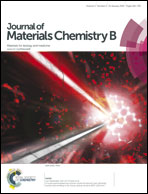Fabrication of a novel partially dissolving polymer microneedle patch for transdermal drug delivery†
Abstract
Polymer microneedles (MNs) have gained increasing attention as a minimally invasive method for efficiently delivering drugs and vaccines in a patient-friendly manner. Herein, an easy and mild process with O2 plasma treatment was used to fabricate polyvinylpyrrolidone (PVP)–polyvinyl alcohol (PVA) MN patches, and efficient, sustained transdermal delivery was achieved. The diffusion rate of the entrained molecules could be controlled by adjusting the ratio of PVP–PVA. Optical coherence tomography was used to monitor the in vitro penetration in real time and to measure the penetration depth. Rhodamine 6G and fluorescein isothiocyanate-labeled bovine serum albumin (BSA-FITC) were used to explore the potential for using partially dissolving MNs as a transdermal delivery device. Confocal microscopy images revealed that the model drug can gradually diffuse from the puncture sites to a deeper depth. The drug-release profile also demonstrated that the PVP–PVA MNs can provide a successful and sustained release and that the transdermal delivery rate was regulated by the PVP–PVA ratio. Furthermore, the two-stage processing strategy developed in this study provides a simple and easy method for localizing the drug in the needle. The partially dissolving MNs developed in this study may serve as a promising device for controlled drug release and for biological storage applications.


 Please wait while we load your content...
Please wait while we load your content...